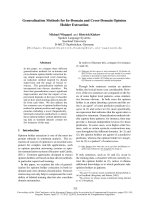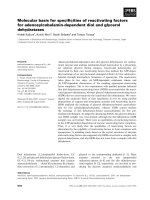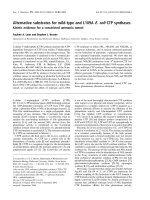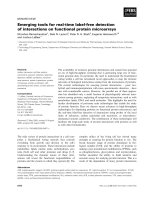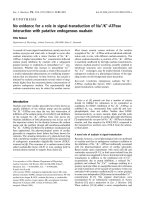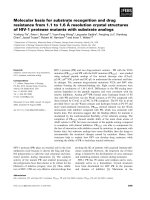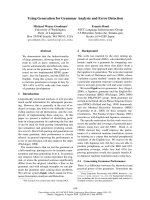Báo cáo khoa học: " Risk factors for retained placenta and the effect of retained placenta on the occurrence of postpartum diseases and subsequent reproductive performance in dairy cows" potx
Bạn đang xem bản rút gọn của tài liệu. Xem và tải ngay bản đầy đủ của tài liệu tại đây (178.56 KB, 7 trang )
-2851$/ 2)
9H W H U L Q D U \
6FLHQFH
J. Vet. Sci.
(2005),
/
6
(1), 53–59
Risk factors for retained placenta and the effect of retained placenta on the
occurrence of postpartum diseases and subsequent reproductive
performance in dairy cows
Yeon-Kyung Han, Ill-Hwa Kim*
College of Veterinary Medicine, Chungbuk National University, Cheongju 361-763, Korea
The objectives of this study were to determine the risk
factors for retained placenta by evaluating several
reproductive factors in individual cows, and to determine
the effects of retained placenta on the occurrence of
postpartum diseases and subsequent reproductive performance
in dairy herds. The health status, cow parity, calving, and
breeding dates were recorded from 805 calvings in nine
dairy herds from October 2000 to March 2004. We used
logistic regression to evaluate the effects of these factors
on the incidence of retained placenta. A stepwise
procedure, used to obtain the appropriate model with
α
=
0.05, revealed that abnormal partus and gestation length
were important risk factors for retained placenta. The
occurrence of endometritis and metabolic disorders was
greater (
p
< 0.01) in the group with retained placentas
than in the control group. The mean intervals from
calving to first service and conception were prolonged (
p
<
0.05) by 7 and 18 days, respectively, in the group with
retained placentas compared to the control group. These
results suggest that abnormal partus and gestation length
are strongly correlated with the development of retained
placenta, which increases the occurrence of postpartum
diseases and subsequently decreases reproductive
performance in dairy herds.
Key words:
Retained placenta, risk factors, postpartum dis-
eases, reproductive performance, dairy cows
Introduction
Expulsion of the placenta usually takes less than 6 to 8 hr
after parturition in cows [52,53]. In practice, the most
commonly used definition of retained placenta is the
presence of fetal membranes 24 hr or longer postpartum
[45]. The condition of retained placenta occurs in 4 to 18%
of calvings [17,18,23,45]. Retained placenta, one of the
main causes of endometritis in cattle, causes economic loss
[31,34]. Kossaibati and Esslemont [37] calculated the direct
cost of a case of retained placenta to be about £ 83, with an
over-all cost of £ 298.29 (1995 prices). Many, often interrelated,
factors have been implicated in the occurrence of retained
placenta [39]. Thus, various risk factors related to
development of retained placenta in individual cows have
been identified, although some are controversial. Calving
problems including dystocia [8,14,17,25], stillbirths [8,45],
and multiple births [1,8,43,47,48,51] are associated with an
increased incidence of retained placenta. In addition to these
problems, abnormalities in partus, parity [43,61], gestation
length [43,47], calving season [43,47], and nutrition [39] are
also considered risk factors for retained placenta. However,
some researchers have found no association between dystocia
[9,10,17], cow parity [47], or calving season [25,38] and the
incidence of retained placenta.
Retained placenta is a direct risk factor for postpartum
reproductive and metabolic disorders [5,24,38], which may
affect subsequent reproductive capability of dairy cows. In
fact, a negative impact of retained placenta on reproductive
performance of dairy cows has been widely documented
[2,21,27,31,40,46,60]. However, others have reported that
retained placenta does not significantly alter fertility
[28,35,54,57].
Risk factors for retained placenta vary among different
regions or countries because of differences in general
management, environment, and herd health control
conditions [20,22]. In addition, effects of retained placenta
on reproductive performance have varied. Our first objective
was to determine the risk factors for retained placenta by
evaluating several factors: calving condition, parity,
gestation length, and calving season in dairy herds in
Chungbuk province, Korea. The second objective was to
determine the effect of retained placenta on the occurrence
of postpartum metabolic and reproductive diseases and on
subsequent reproductive performance.
*Corresponding author
Tel: +82-43-2612571; Fax: +82-43-2673150
E-mail:
54 Yeon-Kyung Han, Ill-Hwa Kim
Materials and Methods
Herds
This study was performed using Holstein dairy farms
located in Boeun county, Chungbuk province, Korea. All
herds contained 50 or more cows and received regular
reproductive health checkups every 4 weeks from
veterinarians at the College of Veterinary Medicine at
Chungbuk National University. The regular reproductive
health checkups included diagnosis and treatment of
reproductive disturbances, pregnancy diagnosis, and
measurement of body condition score [13]. The cows were
maintained in free-stall facilities and fed a total mixed
ration. The ration was based on brewers grain, alfalfa hay,
cotton seed, beet pulp, sweet sorghum, tall fescue, oat hay,
and additives. They were milked twice daily and were
observed for estrus behavior twice a day.
Case definition
An abnormal partus included dystocia (veterinary-assisted
calving or pulling with extreme force), caesarean section,
twins, or stillbirth [21,36]. The postpartum reproductive and
metabolic disorder definitions used in this study are similar
to the definitions used in previous studies [8,11,41,59].
Retained placenta was defined as the retention of the fetal
membrane for > 24 hr [8,36]. Metabolic disorders (abomasal
displacement, milk fever, or ketosis) were diagnosed by
clinical signs observed by the veterinarian and/or farmer
within 4 weeks postpartum. Abomasal displacement was
diagnosed by a pinging sound upon abdominal auscultation
by a veterinarian, and all cases were corrected by surgery.
Milk fever was diagnosed by the presence of the following
clinical signs: weakness, cold skin, and favorable response
to calcium therapy. Ketosis was defined as the presence of
the following clinical signs: anorexia, depression, and odor
of acetone on the breath. Endometritis was diagnosed 4
weeks postpartum by examination by the authors and
diagnosed by the presence of the following clinical signs:
cloudy discharge and enlarged uterus observed by rectal
examination with or without other clinical signs. Therefore,
endometritis included cases of metritis and pyometra as well
as endometritis [15,29]. At the same time, the presence of
ovarian cysts was diagnosed by ultrasound examination
(Sonoace 600 with 5.0 MHz linear-array transducer;
Medison, Korea) based on ovarian structures present: an
ovarian structure of greater than 25 mm internal diameter
with a wall less than 3 mm thick (follicular cyst) and with a
wall more than 3 mm thick (luteal cyst) in the absence of a
normal corpus luteum [59]. Repeat occurrences of these
conditions in a single cow were included.
Data collection and processing for determination of the
risk factors for retained placenta
Data were collected from 805 calvings from nine dairy
herds from October 2000 to March 2004. Table 1 lists
independent variables that describe calving condition, parity,
gestation length, and calving season. In order to evaluate the
influence on development of retained placenta of abnormal
partus (total cases of dystocia, caesarean section, twins and
stillbirth), parity, gestation length, and calving season, we
used logistic regression with the SAS program [55]. Initially,
to determine which independent variables influence
development of retained placenta, simple logistic regression
was applied to each independent variable separately. Later, a
stepwise procedure was used to obtain the appropriate
model with
α
= 0.05. Data about the occurrence of retained
Table 1. Descriptive statistics of data included in the analysis of risk factors for retained placenta in 805 calvings in nine dairy herds
Va r iable s L ev e l
No. of calvings
Retained placenta + Retained placenta -
Abnormal partus
1)
Ye s 2 6 4 2
No 121 616
Gestation length
< 271 24 19
271 - 280 65 332
> 280 58 307
Cow parity
1 27 172
2 41 209
3 35 138
≥ 4 44 139
Calving season
2)
Spring 27 153
Summer 36 187
Autumn 50 154
Winter 34 164
1)
Abnormal partus included dystocia, caesarean section, twins, and stillbirth.
2)
Spring = March to May; Summer = June to August; Autumn = September to November; Winter = December to February.
Retained placenta in dairy cows: Risk factors and effects 55
placenta among individual farms were compared using the
chi-square test.
Evaluation of the effect of retained placenta on the
occurrence of reproductive and metabolic disorders
Cows were grouped based on the occurrence of retained
placenta 24 hr postpartum into the retained placenta group
(n = 147) or the control group (n = 658). Data about the
occurrence of reproductive disorders (endometritis or
ovarian cyst) or metabolic disorders (abomasal displacement,
milk fever, or ketosis) were compared between the two
groups using the chi-square test, or Fishers exact test when
frequencies were too low (< 5) to use the chi-square.
Statistics were performed the SAS program.
Evaluation of the effect of retained placenta on
reproductive performance
The cows were bred at observed estrus more than 50 days
after calving. Artificial insemination (AI) was done
according to the a.m p.m. rule. The conception to AI ratio
was determined per rectum 60 to 70 days after AI by both
ultrasonographical observation and manual palpation.
Reproductive performance data were collected for a
minimum of 7 months postpartum or until pregnancy or
culling. Data on the intervals from calving to first service
and conception between the retained placenta and control
groups were analyzed by
t
-test using the SAS program. For
all tests, a value of
p
< 0.05 was considered significant.
Results
The overall incidence of retained placenta among the 805
calvings was 18.3%, and ranged from 8.3 to 28.1% among
nine dairy herds (Fig. 1). The final model identified
abnormal partus and gestation length as risk factors, while
cow parity and calving season were not identified by the
model (Table 2). Comparison of the occurrence of
postpartum reproductive or metabolic diseases between
cows with and without retained placenta is shown in Table 3.
The occurrence of endometritis or metabolic disorders was
greater (
p
< 0.01) in the retained placenta group than in the
control group. However, the occurrence of ovarian cyst was
not different (
p
> 0.05) between the two groups. The effect
of retained placenta on reproductive performance is shown
in Fig. 2. The intervals from calving to first service (7 days)
and conception (18 days) were more prolonged (
p
< 0.05) in
the retained placenta group than in the control group.
Discussion
The data presented here show that abnormal partus and
gestation length are important risk factors for retained
placenta, which increases the occurrence of postpartum
endometritis and metabolic disorders, resulting in decreased
reproductive performance in dairy herds.
The incidence of retained placenta in this study (18.3%)
was similar to that reported by Markusfeld (17.8%) [45], but
the incidence was higher than some previously reported
F
ig. 1.
Incidence of retained placenta in 805 calvings on ni
ne
d
airy farms. Different letters (a-d) denote significant differen
ce
(
p
<0.05).
F
ig. 2.
Effect of retained placenta on the intervals from calving
to
f
irst service and conception. Values are means±SEM.
*
p
<0.05 compared with controls.
Table 2.
Risk factors for retained placenta analyzed by a stepwise selection procedure on data from 805 calvings in nine dairy herds
Parameter Estimate SEM
p
Odds ratio
95%
Confidence interval
Intercept -0.84 0.15 < 0.001 - -
Abnormal partus
yes vs no -0.33 0.15 0.0327 1.92 [1.055, 3.501]
Gestation length of cows
> 280 vs 271-280
< 271 vs 271-280
-0.55
1.07
0.15
0.23
< 0.001
< 0.001
0.97
4.89
[0.660, 1.433]
[2.412, 9.928]
56 Yeon-Kyung Han, Ill-Hwa Kim
rates (4-14%) [8,18,36,50]. The higher rate in this study may
have resulted from factors related to management, such as
overcrowding resulting in limited exercise [1] and/or
inadequate nutrition [7,9,33].
Retained placenta was significantly associated with
abnormal partus and gestation length in this report.
Increased risk of retained placenta (odds ratio = 1.9) in cows
with abnormal partus was consistent with numerous
previous findings [1,5,818,30,38]. In contrast, veterinary-
assisted dystocia was not associated with retained placenta
in another study [9]. Increased occurrence of retained
placenta in cows with abnormal partus might be due to lack
of tone and slow involution or damage to the uterus by
mechanical stress resulting from calving difficulty
[36,43,45]. Previous reports [5,30,43,47] on the relationship
between gestation length and the incidence of retained
placenta showed that shorter gestation lengths are associated
with a higher incidence of retained placenta. Short
gestations (< 271 days) were also related to an increased risk
of developing retained placenta (odd ratio = 4.9) in this
study. On the other hand, Larson
et al
. [38] reported that
seasons were associated with development of retained
placenta, with a higher incidence rate during the warm
season for the first lactation and during the cold season for
the second lactation.
Cow parity and calving season were eliminated from the
final model since they did not influence the incidence of
retained placenta. Our finding that cow parity is not related
to increased risk of retained placenta is discordant with
previous studies [1,9,17,25], which reported that the
incidence of retained placenta increased with advancing
parity. On the other hand, increased risk for retained
placenta has also been reported in heifers with dystocia [17].
In agreement with other reports [16,25], calving season was
not associated with the incidence of retained placenta in this
study. Yet, calvings during the summer [32,43] or during
periods of heat stress [12] have been associated with higher
incidences of retained placenta. Chassagne
et al
. [5]
observed a decreased incidence of retained placenta in
autumn. Different temperature ranges or management
environments of countries or regions may account for these
varied results.
Our data demonstrated that retained placenta was an
important predisposing factor for development of postpartum
endometritis and metabolic disorder in dairy herds, as
previously reported by others [9,10,44]. The occurrence of
endometritis was greater in the retained placenta group than
in the control group, which is consistent with previous
studies [34,36]. The condition of the uterus at parturition or
soon after may determine whether potential pathogens cause
infections [42]. At this time, retained placenta (a perfect
media for bacterial growth), dystocia, or involution
characteristics of the cervix and uterus may predispose cows
to various infections [4,49]. Thus, the relationship between
retained placenta and endometritis should be considered
carefully; a large proportion of primary endometritis cases
occurred just after the occurrence of retained placenta [43].
The incidence of endometritis after retained placenta in this
study was 78.9%, which is between the incidence rates
reported by Brooks (92%) [3] and by Borsberry and Dobson
(64%) [2]. We assumed that this higher incidence of
endometritis in cows with retained placenta might significantly
affect subsequent reproductive performance. The occurrence
of ovarian cyst was not different between cows with and
without retained placenta, which is consistent with previous
reports [10,27,57]. However, Erb
et al
. [17] found an
indirect association between the occurrence of ovarian cyst
and retained placenta mediated by endometritis. The
occurrence of ovarian cyst appears to be more closely
associated with milk production, cow parity, or calving
season than with retained placenta [26,27]. The occurrence
of metabolic disorder (abomasal displacement, milk fever,
or ketosis) was also greater in the retained placenta group
than in the control group. Cows with retained placenta have
previously been reported to have a higher incidence of
abomasal displacement and ketosis [9,10,45] compared to
cows without retained placenta, although one report did not
find a relationship between retained placenta and abomasal
displacement [8].
The intervals from calving to first service and conception
Table 3.
Comparison of the occurrence of postpartum reproductive and metabolic diseases between cows with and without retained
placenta
Postpartum disorder
Retained placenta
Yes (n = 147) No (n = 658)
p
Reproductive disorder
Endometritis (%)
Ovarian cyst (%)
116 (78.9)
13 (8.8)
208 (31.6)
37 (5.6)
p
<0.01
p
>0.05
Metabolic disorder
Abomasal displacement (%)
Milk fever (%)
Ketosis (%)
Metabolic subtotal (%)
11 (7.5)
3 (2.0)
7 (4.8)
20 (13.6)
13
(2.0)
1 (0.2)
8 (1.2)
21 (3.2)
p
<0.01
p
<0.05
p
<0.01
p
<0.01
Retained placenta in dairy cows: Risk factors and effects 57
were higher in the retained placenta group than in the
control group, which is consistent with other reports
[19,50,56]. In some studies, however, the intervals from
calving to first service and/ or conception were not related to
the occurrence of retained placenta [6,35,47]. The effect of
retained placenta was much greater on the interval from
calving to conception than the effect on the delay in the
interval from calving to first service in this study, consistent
with the report of Borsberry and Dobson [2]. Furthermore,
the delay of 8 days to first service in cows with retained
placenta was similar to the results of Erb
et al
. [17]. On the
other hand, the intervals from calving to first service and
conception in this study were longer than those (83 to 85
days and 109 to 121 days, respectively) in the reports of
Francos and Mayer [23]. Retained placenta has been
suggested to reduce fertility in two ways: first, by a direct
effect through an unknown mechanism and secondly, by an
indirect effect through endometritis [39,58]. Since the
interrelationships among retained placenta, postpartum
reproductive or metabolic disorder, and reproductive
performance have not been determined, the exact route by
which retained placenta affects reproductive performance
has not been clarified in this study. However, considering the
high incidence of endometritis after retained placenta (Table
3), the decreased reproductive performance appears to be
due largely to an indirect effect through endometritis.
In conclusion, abnormal partus and short gestation periods
are important risk factors for development of retained
placenta, which increases the occurrence of endometritis
and metabolic diseases, resulting in decreased reproductive
performance in dairy herds in Chungbuk province, Korea.
Acknowledgments
This work was supported by grant No. R11-2002-100-
02002-0 from ERC program of the Korean Science &
Engineering Foundation. The author thanks Dr. Daehyun
Chung, Department of Statistics, Chungbuk National
University, Korea for statistical analysis of data.
References
1. Bendixen PH, Vilson B, Ekesbo I. Disease frequencies in
dairy cows in Sweden. II. Retained placenta. Prev Vet Med
1987, 4, 377-387.
2. Borsberry S, Dobson H. Periparturient diseases and their
effect on reproductive performance in five dairy herds. Vet
Rec 1989, 124, 217-219.
3. Brooks G. Comparison of two treatments after retained fetal
membranes on clinical signs in cattle. Vet Rec 2001, 148,
243-244.
4. Bruun J, Ersbøll AK, Alban L. Risk factors for metritis in
Danish dairy cows. Prev Vet Med 2002, 54, 179-190.
5. Chassagne M, Barnouin J, Faye B. Descriptive
epidemiology of placental retention in intensive dairy herds
in Brittany. Vet Res 1996, 27, 491-501.
6. Coleman DA, Thayne WV, Dailey RA. Factors affecting
reproductive performance of dairy cows. J Dairy Sci 1985,
68, 1793-1803.
7. Correa MT, Curtis CR, Erb HN, Scarlett JM, Smith RD.
An ecological analysis of risk factors for postpartum
disorders of Holstein-Friesian cows from thirty-two New
York farms. J Dairy Sci 1990, 73, 1515-1524.
8. Correa MT, Erb H, Scarlett J. Path analysis for seven
postpartum disorders of Holstein cows. J Dairy Sci 1993, 76,
1305-1312.
9. Curtis CR, Erb HN, Sniffen CJ, Smith RD, Kronfeld DS.
Path analysis of dry period nutrition, postpartum metabolic
and reproductive disorders, and mastitis in Holstein cows. J
Dairy Sci 1985, 68, 2347-2360.
10. Dohoo IR, Martin SW. Disease, production and culling in
Holstein-Friesian cows. III. Disease and production as
determinants of disease. Prev Vet Med 1984, 2, 671-690.
11. Domecq JJ, Skidmore AL, Lloyd JW, Kaneene JB.
Relationship between body condition scores and conception
at first artificial insemination in a large dairy herd of high
yielding Holstein cows. J Dairy Sci 1997, 80, 113-120.
12. Dubois PR, Williams DJ. Increased incidence of retained
placenta associated with heat stress in dairy cows.
Theriogenology 1980, 13, 115-121.
13. Edmonson AJ, Lean IJ, Weaver LD, Farver T, Webster
G. A body condition scoring chart for Holstein dairy cows. J
Dairy Sci 1989, 72, 68-78.
14. Emanuelson U, Oltenacu PA, Gröhn YT. Nonlinear mixed
model analyses of five production disorders of dairy cattle. J
Dairy Sci 1993, 76, 2765-2772.
15. Emanuelson U, Oltenacu PA. Incidences and effects of
diseases on the performance of Swedish dairy herds stratified
by production. J Dairy Sci 1998, 81, 2376-2382.
16. Erb HN, Martin SW. Interrelationships between production
and reproductive diseases in Holstein cows. Age and seasonal
patterns. J Dairy Sci 1980, 63, 1918-1924.
17. Erb HN, Smith RD, Oltenacu PA, Guard CL, Hillman
RB, Powers PA, Smith MC, White ME. Path model of
reproductive disorders and performance, milk fever, mastitis,
milk yield, and culling in Holstein cows. J Dairy Sci 1985,
68, 3337-3349.
18. Esslemont RJ, Kossaibati MA. Incidence of production
diseases and other health problems in a group of dairy herds
in England. Vet Rec 1996, 139, 486-490.
19. Etherington WG, Martin SW, Dohoo IR, Bosu WTK.
Interrelations between ambient temperature, age at calving,
postpartum reproductive events and reproductive
performance in dairy cows: a path analysis. Can J Comp Med
1985, 49, 254-260.
20. Faye B. Interrelationships between health status and farm
management system in French dairy herds. Prev Vet Med
1991, 12, 133-152.
21. Fourichon C, Seegers H, Malher X. Effect of disease on
reproduction in the dairy cow: a meta-analysis.
Theriogenology 2000, 53, 1729-1759.
22. Fourichon C, Seegers H, Beaudeau F, Verfaille L, Bareille
N. Health-control costs in dairy farming systems in western
58 Yeon-Kyung Han, Ill-Hwa Kim
France. Livest Prod Sci 2001,
68
, 141-156.
23.
Francos G, Mayer E.
Analysis of fertility indices of cows
with extended postpartum anestrus and other reproductive
disorders compared to normal cows. Theriogenology 1988,
29
, 399-412.
24.
Gröhn YT, Erb HN, McCulloch CE, Saloniemi HS.
Epidemiology of metabolic disorders in dairy cattle:
Association among host characteristics, disease, and
production. J Dairy Sci 1989,
72
, 1876-1885.
25.
Gröhn YT, Erb HN, McCulloch CE, Saloniemi HS.
Epidemiology of reproductive disorders in dairy cattle:
associations among host characteristics, disease and
production. Prev Vet Med 1990,
8
, 25-39.
26.
Gröhn YT, Eicker SW, Hertl JA.
The association between
previous 305-day milk yield and disease in New York State
dairy cows. J Dairy Sci 1995,
78
, 1693-1702.
27.
Gröhn YT, Rajala-Schultz PJ.
Epidemiology of
reproductive performance in dairy cows. Anim Reprod Sci
2000,
60/61
, 605-614.
28.
Halpern NE, Erb HN, Smith RD.
Duration of retained
membranes and subsequent fertility in dairy cows.
Theriogenology 1985,
23
, 807-813.
29.
Heuer C, Schukken YH, Dobbelaar P.
Postpartum body
condition score and results from the first test day milk as
predictors of disease, fertility, yield, and culling in
commercial dairy herds. J Dairy Sci 1999,
82
, 295-304.
30.
Joosten I, van Eldik P, Elving L, van der Mey GJW.
Factors related to the etiology of retained placenta in cattle.
Anim Reprod Sci 1987,
14
, 251-262.
31.
Joosten I, Stelwagen J, Dijkhuizen AA.
Economic and
reproductive consequences of retained placenta in dairy
cattle. Vet Rec 1988,
123
, 53-57.
32.
Joosten I, van Eldik P, Elving L, van der Mey GJW.
Factors affecting occurrence of retained placenta in cattle.
Effect of sire on incidence. Anim Reprod Sci 1991,
25
, 11-
22.
33.
Julien WE, Conrad HR, Jones JE, Moxon AL.
Selenium
and vitamin E and incidence of retained placenta in parturient
dairy cows. J Dairy Sci 1976,
59
, 1954-1959.
34.
Kaneene JB, Miller R.
Risk factors for metritis in Michigan
dairy cattle using herd- and cow-based modelling
approaches. Prev Vet Med 1995,
23
, 183-200.
35.
Kaneko K, Kawakami S, Miyoshi M, Abukawa T,
Yamanka S, Mochizuki M, Yoshihara S.
Effect of retained
placenta on subsequent bacteriological and cytological
intrauterine environment and reproduction in Holstein dairy
cows. Theriogenology 1997,
48
, 617-624.
36.
Klerx HJ, Smolders EAA.
Herd and cow random variation
in models of interrelationships between metabolic and
reproductive disorders in high yielding multiparous Holstein
dairy cattle in The Netherlands. Livest Reprod Sci 1997,
52
,
21-29.
37.
Kossaibati MA, Esslemont RJ.
The costs of production
diseases in dairy herds in England. Vet J 1997,
154
, 41-51.
38.
Larson LL, Ishak MA, Owen FG, Erickson ED, Lowry
SR.
Relationship of physiological factors to placental
retention in dairy cattle. Anim Reprod Sci 1985,
9
, 31-43.
39.
Laven RA, Peters AR.
Bovine retained placenta: aetiology,
pathogenesis and economic loss. Vet Rec 1996,
139
, 465-
471.
40.
Lee LA, Ferguson JD, Galligan DT.
Effect of disease on
days open assessed by survival analysis. J Dairy Sci 1989,
72
,
1020-1026.
41.
Loeffler SH, de Vries MJ, Schukken YH.
The effects of
time of diseases occurrence, milk yield, and body condition
on fertility of dairy cows. J Dairy Sci 1999,
82
, 2589-2604.
42.
Lewis GS.
Health problem of the postpartum cow: Uterine
health and disorders. J Dairy Sci 1997,
80
, 984-994.
43.
Markusfeld O.
Factors responsible for post parturient
metritis in dairy cattle. Vet Rec 1984,
114
, 539-542.
44.
Markusfeld O.
The association of displaced abomasums
with various pariparturient factors in dairy cows. A
retrospective study. Prev Vet Med 1986,
4
, 173-183.
45.
Markusfeld O.
Periparturient traits in seven high dairy
herds. Incidence rates, association with parity, and
interrelationships among traits. J Dairy Sci 1987,
70
, 158-
166.
46.
Martin JM, Wilcox CJ, Moya J, Klebanow EW.
Effects of
retained fetal membranes on milk yield and reproductive
performance. J Dairy Sci 1986,
69
, 1166-1168.
47.
Muller LD, Owens MJ.
Factors associated with the
incidence of retained placentas. J Dairy Sci 1974,
57
, 725-
728.
48.
Nielen M, Schukken YH, Scholl DT, Wilbrink HJ, Brand
A.
Twinning in dairy cattle: A study of risk factors and
effects. Theriogenology 1989,
32
, 845-862.
49.
Oltenacu PA, Britt JH, Braun RK, Mellenberger RW.
Relationships among type of parturition, type of discharge
from genital tract, involution of cervix, and subsequent
reproductive performance in Holstein cows. J Dairy Sci
1983,
66
, 612-619.
50.
Ouweltjes W, Smolders EAA, Elving L, van Eldik P,
Schukken YH.
Fertility disorders and subsequent fertility in
dairy cattle. Livest Prod Sci 1996,
46
, 213-220.
51.
Peeler EJ, Otte MJ, Esslemont RJ.
Inter-relationships of
periparturient diseases in dairy cows. Vet Rec 1994,
134
,
129-132.
52.
Rebhun WC.
Diseases of dairy cattle. Lea & Febiger, pp.
315-317, London, 1995.
53.
Roberts SJ.
Veterinary obstetrics and genital diseases. 3rd
ed. pp. 373-382, Woodstock, Vermont, 1986.
54.
Sandals WCD, Curtis RA, Cote JF, Martin SW.
The effect
of retained placenta and metritis complex on reproductive
performance in dairy cattle: a case control study. Can Vet J
1979,
20
, 131-135.
55.
SAS.
SAS System, Release 8.1, SAS Inst Inc, Cary, 1999.
56.
Schindler H, Eger S, Davidson M, Ochowski D,
Schermerhorn EC, Foote RH.
Factors affecting response of
groups of dairy cows managed for different calving-
conception intervals. Theriogenology 1991,
36
, 495-503.
57.
Shanks RD, Freeman AE, Berger PJ.
Relationship of
reproductive factors with interval and rate of conception. J
Dairy Sci 1979,
62
, 74-84.
58.
Stevenson JS, Call EP.
Reproductive disorders in the
periparturient dairy cow. J Dairy Sci 1988,
71
, 2572-2583.
59.
Tebble JE, O’Donnell MJ, Dobson H.
Ultrasound diagnosis
Retained placenta in dairy cows: Risk factors and effects 59
and treatment outcome of cystic ovaries in cattle. Vet Rec
2001,
148
, 411-413.
60.
Thompson JR, Pollak EJ, Pelissier CL.
Interrelationships
of parturition problems, production of subsequent lactation,
reproduction, and age at first calving. J Dairy Sci 1983,
66
,
1119-1127.
61.
van Werven, Schukken YH, Lloyd J, Brand A, Heeringa
HT, Shea M.
The effect of duration of retained placenta on
reproduction, milk production, popartum disease and culling
rate. Theriogenlogy 1992,
37
, 1191-1203.

